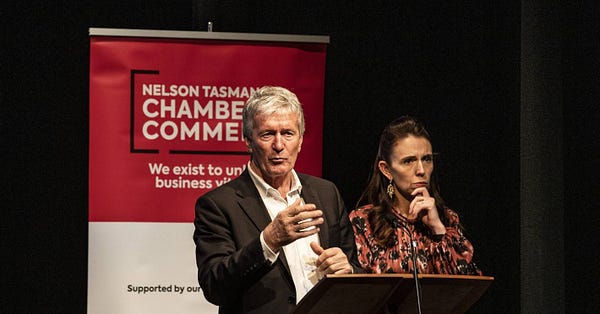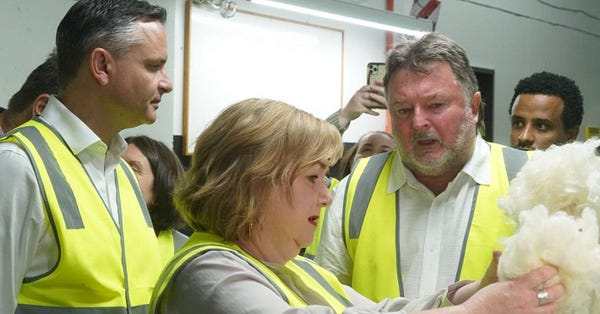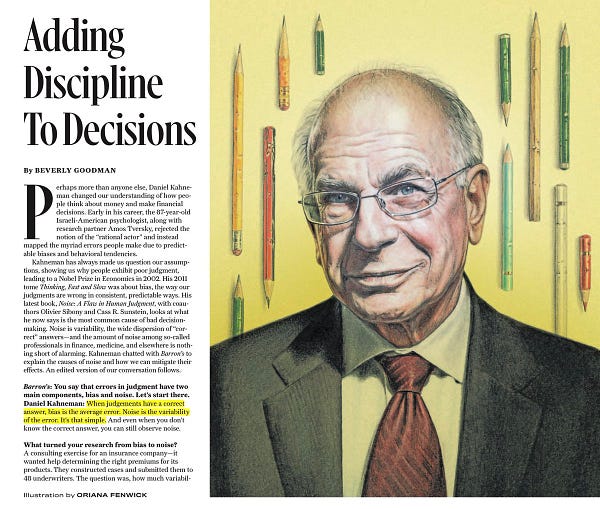TLDR & TLDL: Social unemployment insurance is a good idea if it’s broad and deep enough to really strengthen our social safety net, but it must also be accompanied with improvements in the regular dole and sickness benefits to avoid the further widening of the gap between the rich and poor, the old and the young, and property owners and renters.
Currently, it’s pitched as a nearly costless ACC-style scheme that isn’t a tax hike, but any decent Scandinavian-style scheme will have to see the size of Government increase as a share of GDP from the current 30% of GDP to a more Scandi-styled 50% of GDP.
The devil in the unemployment insurance detail
My ‘When the facts change’ podcast for the Spinoff over the weekend was about the push by Finance Minister Grant Robertson, the CTU and BusinessNZ for a European-style and ACC-like unemployment insurance scheme. I spoke at length with the CTU’s Richard Wagstaff and BusinessNZ’s Kirk Hope about how it came about, the curly detail that needs to be sorted and the pros and cons of such a scheme.
In my view, the key pressure points in the negotiations will be:
Will health and disability insurance be wrapped into the scheme?
Including income support, rehabilitation and support whenever someone becomes too ill to work is often part of the schemes used overseas and would fit well with the ACC-ness of the scheme. It would also fix a yawning gap in our current system where accidents are covered by ACC, but illness is not. It would also answer the critics of the idea who worry people who are on sickness benefits will fall into a much lower tier of income support.
But it would significantly increase the cost of the scheme and BusinessNZ have said they don’t want it in, or at least don’t want to pay for it. The CTU want it in.
Will contributions be made ACC-style, or through PAYE?
IRD tends to be first cab off the rank for running these ‘extra’ types of schemes. They already have student loans, Working For Families, KiwiSaver, child support and paid parental leave. The contributions could be collected via PAYE, which would make the political and logistical optics relatively ‘painless’ from a worker and employer point of view. But it does raise the question of who is paying for it. Would there be a one-off increase, similar to a tax increase where the worker and employer ‘pay’ an equal amount? Would it be instead of a pay increase, or be in additional to the regular pay increase? It could be used as a ‘clever’ way to engineer a one-time pay increase that is not spent in the economy to take any pressure of price inflation. This was done in Australia in the early 1990s with its ‘Accord,’ which substituted a pay increase for the creation of its now-massive compulsory superannuation scheme.
But the money could be collected by a new organisation altogether, which collects levies in the same way ACC does. That would make it much easier to include contractors. But there would be the question of whether contractors pay the full 100% in the way they pay ACC now, which would incentivise employers to shift to employment contract arrangements, further worsening job security and (often) pay in the process. One of the reasons for social insurance is to soften the pain of increased insecurity and lower wages and conditions in the future of work in a world of AI and robots, not make it worse.
Will contractors and freelancers have to contribute, as they do for ACC?
This is a key question, given there’s a risk that contractors could opt out of the scheme and increase the incentives for employers (and some workers) to get around the costs and shift to more of a contracting-out model. Obviously, the CTU wants as many people as possible in. BusinessNZ has also pointed to ACC as the model. One of the questions will be how employers pay their share when their wage bill is going out as contractor payments. One suggestion is for a ‘share of remuneration’ rather than PAYE-based arrangement.
Will there be mandatory redundancy payments as well?
One of the reasons BusinessNZ is keen on being involved in creating the scheme is to avoid the Government introducing mandatory redundancy protection, as is seen overseas. New Zealand is one of the few places in the world without it. BusinessNZ is particularly keen to avoid it because it would force companies to include it as a liability on their balance sheets.
Large companies with lots of long-term employees would face a potentially one-off massive new liability to report to shareholders that would automatically reduce the equity or market value in the company. In some cases where companies were heavily indebted they could become insolvent, or breach their debt covenants with banks. The CTU says it still wants mandatory redundancy payout protection.
But my understanding is there was a debate in the union movement about whether to go for mandatory redundancy protection OR social insurance, and social insurance won out. My feeling is this will be ruled out early on, as the price of keeping employers on board.
Will any extra Government spending go on social insurance OR main benefit increases?
The big fear of those on the left in the anti-poverty activist community is social insurance will create a two-tiered benefit system that means workers with ‘proper’ full time jobs get ‘gold-plated’ benefits and retraining, while the already-longterm unemployed, those on sickness benefits and sole benefits, get stuck on the current (still) very-low benefit levels without the same retraining benefits. They fear the creation of a tier of ‘deserving’ beneficiaries not subject to MSD’s sanctions regime, set apart from the ‘undeserving’ beneficiaries locked into poverty.
Sceptics also worry the benefits of such a scheme will be weighted towards older, Pakeha, male employees in ‘proper’ jobs with higher incomes. They fear women, Pakeha, Pacifika and young people, who are more often in low paid, insecure, gig economy work, will miss out. They point to places such as France where many employers now avoid taking on full-time ‘proper’ workers and contract out new work. That has created a generational divide between the young, who are on insecure and lower paid contract work, and older workers who probably own their own home.
The proponents of unemployment insurance say the Government can ‘walk and chew gum’ by both introducing social insurance and increasing benefits at the same time. They also argue that taking the load of ‘regular’ job churn benefits off MSD would allow MSD to focus more and provide a better service to long-term beneficiaries.
Can the scheme be started before the 2023 election?
The political calculus behind this push for social or unemployment insurance is the unique position of the Government in this term as a one-party Government with untrammelled power to change legislation without having to defer to or negotiate with a more centrist coalition partner. That’s the incentive for both Labour and the the CTU to push ahead and get the scheme in place before the election, and for BusinessNZ to stay involved so employers at least have a seat at the table when the laws are being written.
They will both want the scheme in and people contributing before the election to avoid the NZ Superannuation ‘Dancing Cossacks’ risk of it being cancelled by a new Government before it comes in. It will be much harder to change once it’s in.
The boundary issues
These will generate heat. One of the biggest ones will be whether people can receive BOTH unemployment insurance and NZ Superannuation (and potentially defined benefit work pensions) if they’re made redundant over the age of 65. Then there’s the area of those made ill at work, and whether they should receive social insurance, particularly around mental health. The area of people pushed out of work by bullying and harassment will be sensitive. ACC doesn’t handle this at all well at the moment.
My view?
It’s a good idea if it ensures the inclusion of health and disability insurance, decent retraining allowances and mentoring, and doesn’t ‘punish’ new employees by weighting the benefits to workers who have been in the job for a long time. It also needs to essentially redistribute the money from older, richer and frankly whiter workers to the benefits paid to those on less secure and lower paid work.
This gets to the heart of any insurance scheme. It is designed to reduce the risks for individuals by socialising the losses, but the most desirable schemes for customers are the ones that most accurately assess the risks for individuals and price them accordingly to avoid much ‘transfer’ of value from low-risk and wealth customers to high-risk and poorer ones.
It should also be associated with significant increases in benefits for long-term unemployed and sickness benefits to avoid the two-tiered benefits issue.
Ultimately, the type of social insurance scheme that both the CTU and BusinessNZ want are those used in Scandinavian countries such as Sweden and Denmark, which also have much higher shares of national income going to the Government in the form of both tax and social insurance premia. New Zealand’s ‘Government’ share of income is around 30% right now. It is closer to 50% in these countries.
The implication in this New Zealand debate is that somehow we can build a scheme that doesn’t increase the size of Government or the tax take, either for workers or companies. The Government will be able to make some sort of ‘neutral’ contribution by substituting existing dole costs for its contribution. Employers may concede some slight increase in their ‘tax’ to offset the large and immediate financial shock of mandatory unemployment insurance liabilities. But will employees be happy contributing a little bit extra for a stronger social safety net, particularly if the richer and more secure workers know or realise they are effectively subsidising poorer and less secure workers.
I asked the PM about whether this was a tax increase, which she has previously ruled. She said it wasn’t as it was an ACC-style levy. That will fly if it is small and somehow largely subsidised by the Government and employers. But a decent scheme will cost extra as a percentage of GDP.
An Aotearoa Accord?
One political solution may be to use the Australian Accord example as engineering the effective tax increase on both workers and employers as a substitute for a wage increase, in part to avoid some sort of wage inflation breakout in a recovery. That will be harder than in Australia, where the union movement there was much stronger and had a much higher share of private sector workers in the early 1990s.
Also, I wrote a piece to go with the Podcast on The Spinoff titled: Koru class dole’ or not, this is a really big deal’, which goes into more depth around the reasons why this is being attempted. It’s really about the experience of Murupara. I grew up next door in Galatea and went to the same school as Jacinda Ardern, albeit at different times.
Elsewhere briefly in our political economy






Briefly in the global political economy




Notable other views
Longer reads worth your time





Some fun things
The sun rose at 7:36 am in Wellington this morning. It will also rise at 7:36 am tomorrow. The autumnal equinox was on March 21, when the sun rose at 7:24 am. The sun rose at 7:29 am on my birthday, March 26, so our ‘send’ time for the Dawn Chorus will be around then from now on.
























